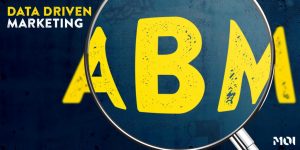4 min read

If, as everybody says nowadays, data is the new oil, any out-of-date, inaccurate data you hold will gunk up your pipelines.
But B2B marketers are a smart group so they already know the importance of data accuracy. In fact, 80% surveyed in Radius and Demand Metric’s research blamed data quality for ineffective demand generation processes.
So, I’m not going to preach the benefits of data – you’re already converted. You know that, when it’s handled with the care it deserves, data is an incredibly powerful weapon in your marketing arsenal.
Predictive analytics is a lifeboat for B2B marketers
If you’re like most other B2B brands, you’re awash in a sea of data. But even an ocean isn’t going to generate leads if you drown in it.
Enter predictive analytics.
With computer power increasing massively while costs plummet, computers can make calculations in seconds which used to take humans hours, days or even weeks to solve. Now, cloud computing means you can even do without the hassle and costs of ownership or the regular and expensive upgrades needed to stay on top.
Predictive analytics makes use of this computing power to spot patterns within data, even data that’s taken from multiple sources and multiple systems.
But you can only get to this fun stuff once you’ve gotten rid of all your dirty data. After all, what’s the point of making connections between data points when the data is wrong? Any insights your analytics platform generates will be useless.
That’s why it’s so important to have clean data.
Why predictive analytics is such a big deal
As a B2B marketer you likely have lots of data over multiple systems.
Now, let’s take your CRM as an example. At a basic level, the data it contains lets you send out marketing emails to people. Taking it up a notch, you might learn from things like how successful an email was based on the open rate. But it can’t make connections with other data sets and tell you why your latest email flopped.
The data you’re seeing is just the tip of the iceberg. What predictive analytics does is uncover the buying signals that are submerged under all the noise. It automatically makes all the connections between bits of data that would be almost impossible for anybody but an Einstein to calculate. You can create links between all the data sets you own, as well as third-party data, to provide context around everything you do and the results you achieve.
You can then use these insights to make better decisions in the future. Sticking with the CRM/email example, predictive analytics can show you what your targets are currently talking about and which services they’re currently looking to buy, and help you tailor your messaging.
Predicting the future
It’s not just a fairy tale. It’s not hypothetical. It’s not just some fancy math stuck inside a computer. Predictive analtyics already has visible, real-world benefits.
For example, hospitals are starting to use it to improve general population health. Granted, this is a side effect of their main aim of improving the bottom line through cost reduction, but by combining and analyzing multiple data sources, they can get a clearer picture of what’s causing readmissions.
As readmissions make up a significant part of healthcare costs, joining up the dots between socioeconomic factors like incomes, addresses, crime rates and air pollution, lets them predict when patients are likely to return to hospital.
These insights let them change their approach – they found that even something as simple as a phone call at the right time after an operation can reduce the chance of readmission.
A B2B marketer can take the same approach of looking at what’s already happened to predict the future.
Churn prevention
Predictive analytics can help you understand the different parts of the funnel or different situations where customers or prospects are leaving. Then you can change your approach at these points to keep people engaged or fix any issues before they happen.
Identify accounts that will spend most money
You’ll be able to predict which accounts will spend the most money. You can make your marketing dollars go further by spending them on accounts that will give you the highest returns. Predictive analytics can be particularly useful in account-based marketing.
Finding your next customers
Again, this is great for ABM. Predictive analytics will let you look at your current successes to reveal other markets you could target – even specific businesses, and individuals within those businesses.
The right place at the right time
When you combine data on somebody’s buying habits with online behavior such as what they’re tweeting about, you can make some good predictions on what sorts of products or services they’re currently in the market for and how, where and when is best to reach out to them, and what messaging is most likely to engage them.
If a customer buys one thing from you, what else might they buy? Predictive analytics can help marketers decide what actions to take next to grow the revenue from a particular account.
I predict happier customers
Predictive analytics can help you make customers happier. Throughout a customer’s journey, you can match any action your business takes to its outcome. Everything from customer service to a customer’s experience and satisfaction of a service can be improved, because you can base future actions on what worked before and not do the things that turned customers off.
Crap in, crap out
I get it, there’s a real shortage of data scientists. And predictive analytics sounds really complicated. It is complicated. But the great thing about predictive analytics is that the algorithms and machine learning built into the many platforms on the market do all the hard work for you.
Your end of the bargain, however, is to keep your data clean and up to date.
If your data’s wrong, you won’t have an accurate picture of what’s happening right now, so you’re not going to be able to predict what could happen in the future.
Remember: crap in, crap out.
Get in touch if you’d like to talk more about how predictive analytics can improve your next marketing campaign.
Related content









